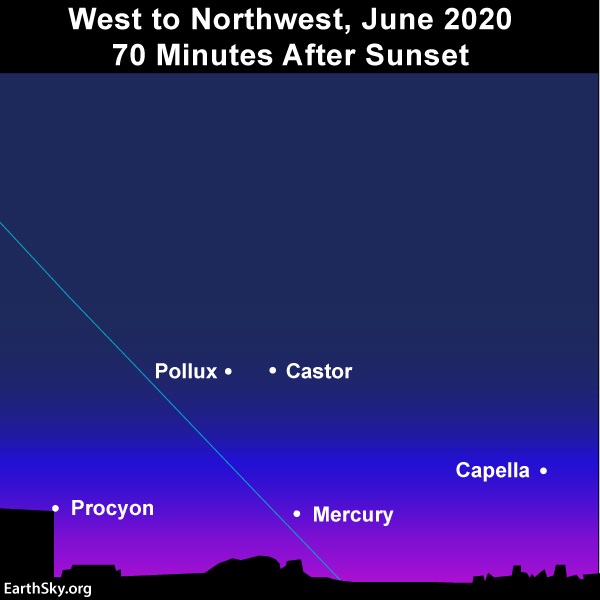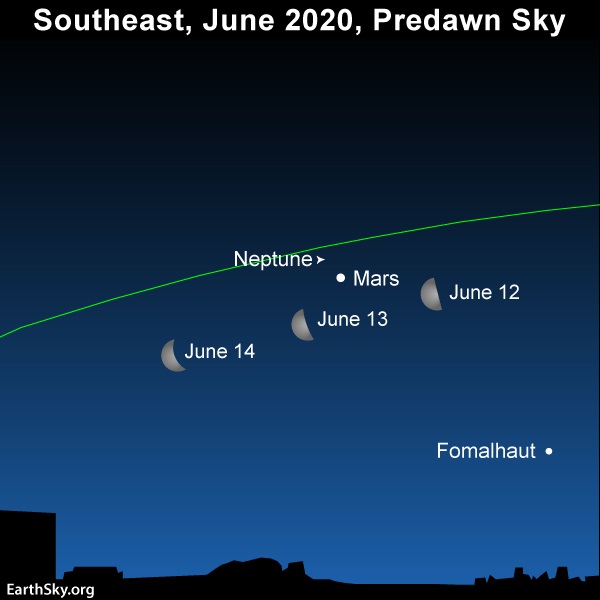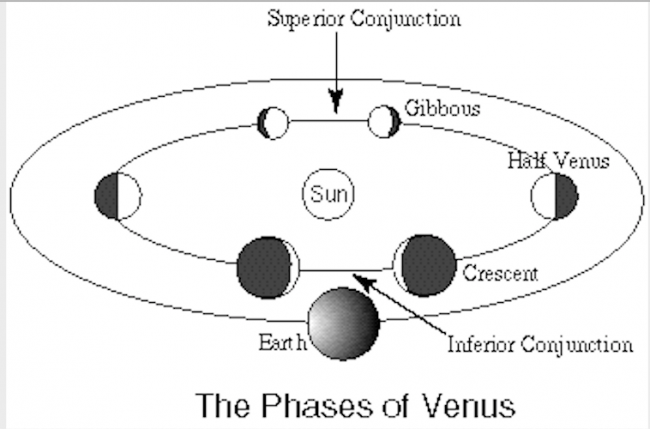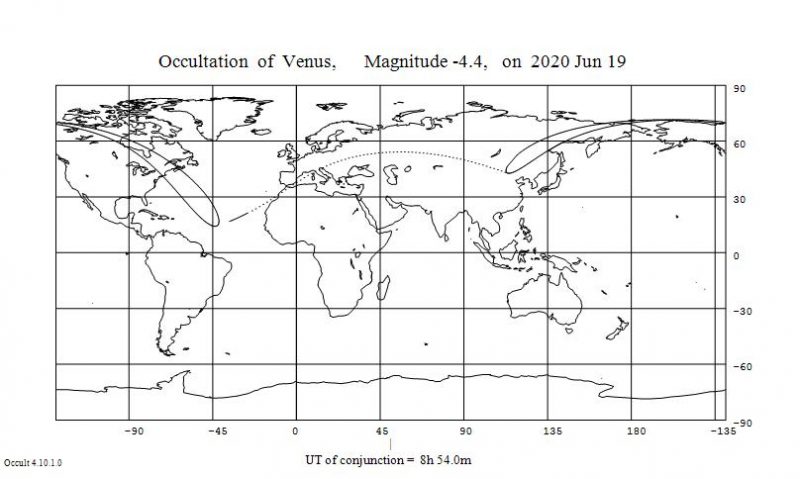
Click the name of a planet to learn more about its visibility in June 2020.
Evening planets: Mercury (dusk), Jupiter and Saturn (rise at mid-to-late evening)
Morning planets: Venus (dawn), Jupiter, Saturn and Mars (predawn/dawn sky).
Try Stellarium for a precise view of the planets from your location.
Want precise planet rise and set times? Click here for recommended almanacs

Mercury reaches its greatest evening elongation on June 4, 2020. Read more.

On June 7 and 8, at mid-to-late evening, look for the waning gibbous moon to rise in your southeast sky. The moon will be near the planets Jupiter and Saturn. Read more.

At mid-northern latitudes, you’ll have to get up mighty early to catch the moon and the red planet Mars in the predawn sky! Read more.

The lit side of the waning crescent moon points to the planet Venus on June 17 and 18, 2020. If you live at the right spot worldwide, you can watch the lunar occultation of Venus on June 19, 2020. Read more.
Venus – the brightest planet – is lost in the sun’s glare for the first week or two in June 2020. Venus swings in front of the sun (at inferior conjunction) on June 3, 2020, to transition out of the evening sky and into the morning sky. Look for Venus to reappear in the eastern dawn by around mid-June.

Inferior conjunction – when Venus sweeps between the sun and Earth – happens on June 3, 2020. Just before inferior conjunction, we see Venus as a thin waning crescent in the evening sky; and just after inferior conjunction, we see Venus as a thin waxing crescent in the morning sky. Image via UCLA.
Around the world, Venus pretty much rises and sets with the sun in early June 2020.
At mid-northern latitudes, Venus rises about an hour before the sun in mid-June, increasing to about 2 hours by the month’s end.
At and near the equator, Venus rises about 1 1/4 hours before the sun in mid-June, increasing to about 2 1/3 hours near the month’s end.
At temperate latitudes in the Southern Hemisphere, Venus rises about 1 1/3 hours before the sun in mid-June, increasing to about 2 2/3 hours by the month’s end.
After Venus swings over into the morning sky in early June, Venus in its faster orbit around the sun will be going farther and farther away from Earth. As viewed through the telescope, Venus’ waxing crescent phase will widen, yet its overall disk size will shrink. Venus’ disk is 0% illuminated on June 3, and about 18% illuminated by the month’s end; Venus’ angular diameter, on the other hand, will shrink to 3/4th the size by the month’s end.
All the same, Venus will brighten throughout the month and into July. Look for Venus to beam at its brightest in the morning sky on or around July 10, 2020, when Venus displays its greatest illuminated extent on the sky’s dome. Venus always beams at its brightest best when its disk is about one-quarter illuminated by sunshine.
Look for the waning crescent moon in the vicinity of Venus for several days, starting on or near June 17. In fact, if you live at the right spot on Earth, you can watch the moon occult (cover over) Venus on June 19, 2020.

The swath of the globe to the north of, or above, the dotted curve (Greenland, northwestern Europe and northern Asia) has the June 19th occultation of Venus in a daytime sky. At the far west (left) of the occultation viewing area (northeast North America), the occultation takes place at dawn June 19. Worldwide map via the International Occultation Timing Association (IOTA). Read more.
Mercury reaches its greatest eastern (evening) elongation from the setting sun on June 4, 2020. Have binoculars handy, however, for Mercury has to compete with the glow of evening twilight. Given an unobstructed horizon in the direction of sunset, you have a reasonably good chance of catching Mercury during the first week of June. This world is dimming daily, though, and by mid-June, Mercury will be about four times fainter. In other words, early June presents your best shot for catching Mercury after sunset.
At mid-northern latitudes, Mercury sets about 1 5/6 hours after the sun in early June, tapering to 1 1/4 hours by mid-month.
At or near the equator, Mercury sets about 1 2/3 hours after the sun in early June, tapering to 1 1/3 hours by mid-month.
At temperate latitudes in the Southern Hemisphere, Mercury sets about 1 1/2 hours after sunset throughout the the first half of June.
Mercury transitions out of the evening sky and into the morning sky on July 1, and then reaches its greatest elongation in the morning sky on July 22, 2020.
Jupiter and Saturn are near one another on the sky’s dome, with Saturn following Jupiter westward across the sky from mid-to-late evening till dawn. Look first for brilliant Jupiter and you’ll find Saturn a short hop to the east of the king planet. Remember, east is in the direction of sunrise. Although Saturn is easily as bright as a 1st-magnitude star, the ringed planet pales next the the king planet Jupiter, which outshines Saturn by some 15 times.
At mid-northern latitudes, Jupiter and nearby Saturn rise at late evening in early June and by the month’s end at nightfall.
At temperate latitudes in the Southern Hemisphere, Jupiter and Saturn rise at mid-evening in early June, and by nightfall at the month’s end.
Mars, which is a bit brighter than Saturn, more or less aligns with Jupiter and Saturn in the predawn/dawn sky. However, standoffish Mars is a long jump to the east of Jupiter and Saturn. Saturn shines between Jupiter and Mars, though much closer to Jupiter.
Watch for the moon in the vicinity of Jupiter and Saturn for several days, centered on or near June 8.

Are you an early riser? In June 2020, Jupiter and Saturn climb up highest for the night just before dawn. If you’re not one to get up early, try catching the planets Jupiter and Saturn low in the southeast sky before your bedtime. Read more.
Mars is the last of the three bright morning planets to rise in June 2020. Jupiter rises first, closely followed by Saturn, and then a few to several hours later by Mars. Whereas Jupiter and Saturn almost rise in tandem, Mars is off by itself in a rather dim section of sky.
At mid-northern latitudes, Mars rises about an hour after midnight in early June, and near the midnight hour by the month’s end. By midnight, we mean midway between sunset and sunrise.
At temperate latitudes in the Southern Hemisphere, Mars comes up at or near the midnight hour throughout the month.
Let the waning crescent moon help guide your eye to Mars for several mornings, centered around June 13.
In June 2020 … you’ll find Mars respectably bright – easily as brilliant as a 1st-magnitude star – before dawn. Earth will be rushing along in its smaller, faster orbit, gaining on Mars, the fourth planet outward from the sun. Throughout the next several months, watch for Mars to brighten dramatically as Earth closes in on Mars. The red planet will appear brightest in our sky and fiery red – around the time of its opposition – when Earth passes between Mars and the sun on October 13, 2020. At that wondrous time, Mars will actually supplant Jupiter as the sky’s fourth-brightest celestial body, after the sun, moon, and the planet Venus, respectively.

View at EarthSky Community Photos. | From Paul Armstrong, who took this photo of Mars, Saturn and Jupiter on the morning of April 15, 2020, from Exmoor, U.K. Jupiter is at the upper right, Mars at center left, with Saturn between them. In May 2020, Jupiter and Saturn were closer together, whereas Mars was farther away from Jupiter and Saturn. Thanks, Paul!
What do we mean by bright planet? By bright planet, we mean any solar system planet that is easily visible without an optical aid and that has been watched by our ancestors since time immemorial. In their outward order from the sun, the five bright planets are Mercury, Venus, Mars, Jupiter and Saturn. These planets actually do appear bright in our sky. They are typically as bright as – or brighter than – the brightest stars. Plus, these relatively nearby worlds tend to shine with a steadier light than the distant, twinkling stars. You can spot them, and come to know them as faithful friends, if you try.
Bottom line: June 2020 presents all 5 bright solar system planets. Catch Mercury at dusk in early June, and Venus at dawn in the second half of the month. Jupiter and Saturn are rising earlier in the evening each day, and may be up before bedtime by mid-month. Look for Mars in the predawn/dawn sky, a long way to the east of Jupiter and Saturn.
Don’t miss anything. Subscribe to EarthSky News by email
Visit EarthSky’s Best Places to Stargaze, and recommend a place we can all enjoy.
Help EarthSky keep going! Donate now.
Post your planet photos at EarthSky Community Photos
from EarthSky https://ift.tt/1YD00CF

Click the name of a planet to learn more about its visibility in June 2020.
Evening planets: Mercury (dusk), Jupiter and Saturn (rise at mid-to-late evening)
Morning planets: Venus (dawn), Jupiter, Saturn and Mars (predawn/dawn sky).
Try Stellarium for a precise view of the planets from your location.
Want precise planet rise and set times? Click here for recommended almanacs

Mercury reaches its greatest evening elongation on June 4, 2020. Read more.

On June 7 and 8, at mid-to-late evening, look for the waning gibbous moon to rise in your southeast sky. The moon will be near the planets Jupiter and Saturn. Read more.

At mid-northern latitudes, you’ll have to get up mighty early to catch the moon and the red planet Mars in the predawn sky! Read more.

The lit side of the waning crescent moon points to the planet Venus on June 17 and 18, 2020. If you live at the right spot worldwide, you can watch the lunar occultation of Venus on June 19, 2020. Read more.
Venus – the brightest planet – is lost in the sun’s glare for the first week or two in June 2020. Venus swings in front of the sun (at inferior conjunction) on June 3, 2020, to transition out of the evening sky and into the morning sky. Look for Venus to reappear in the eastern dawn by around mid-June.

Inferior conjunction – when Venus sweeps between the sun and Earth – happens on June 3, 2020. Just before inferior conjunction, we see Venus as a thin waning crescent in the evening sky; and just after inferior conjunction, we see Venus as a thin waxing crescent in the morning sky. Image via UCLA.
Around the world, Venus pretty much rises and sets with the sun in early June 2020.
At mid-northern latitudes, Venus rises about an hour before the sun in mid-June, increasing to about 2 hours by the month’s end.
At and near the equator, Venus rises about 1 1/4 hours before the sun in mid-June, increasing to about 2 1/3 hours near the month’s end.
At temperate latitudes in the Southern Hemisphere, Venus rises about 1 1/3 hours before the sun in mid-June, increasing to about 2 2/3 hours by the month’s end.
After Venus swings over into the morning sky in early June, Venus in its faster orbit around the sun will be going farther and farther away from Earth. As viewed through the telescope, Venus’ waxing crescent phase will widen, yet its overall disk size will shrink. Venus’ disk is 0% illuminated on June 3, and about 18% illuminated by the month’s end; Venus’ angular diameter, on the other hand, will shrink to 3/4th the size by the month’s end.
All the same, Venus will brighten throughout the month and into July. Look for Venus to beam at its brightest in the morning sky on or around July 10, 2020, when Venus displays its greatest illuminated extent on the sky’s dome. Venus always beams at its brightest best when its disk is about one-quarter illuminated by sunshine.
Look for the waning crescent moon in the vicinity of Venus for several days, starting on or near June 17. In fact, if you live at the right spot on Earth, you can watch the moon occult (cover over) Venus on June 19, 2020.

The swath of the globe to the north of, or above, the dotted curve (Greenland, northwestern Europe and northern Asia) has the June 19th occultation of Venus in a daytime sky. At the far west (left) of the occultation viewing area (northeast North America), the occultation takes place at dawn June 19. Worldwide map via the International Occultation Timing Association (IOTA). Read more.
Mercury reaches its greatest eastern (evening) elongation from the setting sun on June 4, 2020. Have binoculars handy, however, for Mercury has to compete with the glow of evening twilight. Given an unobstructed horizon in the direction of sunset, you have a reasonably good chance of catching Mercury during the first week of June. This world is dimming daily, though, and by mid-June, Mercury will be about four times fainter. In other words, early June presents your best shot for catching Mercury after sunset.
At mid-northern latitudes, Mercury sets about 1 5/6 hours after the sun in early June, tapering to 1 1/4 hours by mid-month.
At or near the equator, Mercury sets about 1 2/3 hours after the sun in early June, tapering to 1 1/3 hours by mid-month.
At temperate latitudes in the Southern Hemisphere, Mercury sets about 1 1/2 hours after sunset throughout the the first half of June.
Mercury transitions out of the evening sky and into the morning sky on July 1, and then reaches its greatest elongation in the morning sky on July 22, 2020.
Jupiter and Saturn are near one another on the sky’s dome, with Saturn following Jupiter westward across the sky from mid-to-late evening till dawn. Look first for brilliant Jupiter and you’ll find Saturn a short hop to the east of the king planet. Remember, east is in the direction of sunrise. Although Saturn is easily as bright as a 1st-magnitude star, the ringed planet pales next the the king planet Jupiter, which outshines Saturn by some 15 times.
At mid-northern latitudes, Jupiter and nearby Saturn rise at late evening in early June and by the month’s end at nightfall.
At temperate latitudes in the Southern Hemisphere, Jupiter and Saturn rise at mid-evening in early June, and by nightfall at the month’s end.
Mars, which is a bit brighter than Saturn, more or less aligns with Jupiter and Saturn in the predawn/dawn sky. However, standoffish Mars is a long jump to the east of Jupiter and Saturn. Saturn shines between Jupiter and Mars, though much closer to Jupiter.
Watch for the moon in the vicinity of Jupiter and Saturn for several days, centered on or near June 8.

Are you an early riser? In June 2020, Jupiter and Saturn climb up highest for the night just before dawn. If you’re not one to get up early, try catching the planets Jupiter and Saturn low in the southeast sky before your bedtime. Read more.
Mars is the last of the three bright morning planets to rise in June 2020. Jupiter rises first, closely followed by Saturn, and then a few to several hours later by Mars. Whereas Jupiter and Saturn almost rise in tandem, Mars is off by itself in a rather dim section of sky.
At mid-northern latitudes, Mars rises about an hour after midnight in early June, and near the midnight hour by the month’s end. By midnight, we mean midway between sunset and sunrise.
At temperate latitudes in the Southern Hemisphere, Mars comes up at or near the midnight hour throughout the month.
Let the waning crescent moon help guide your eye to Mars for several mornings, centered around June 13.
In June 2020 … you’ll find Mars respectably bright – easily as brilliant as a 1st-magnitude star – before dawn. Earth will be rushing along in its smaller, faster orbit, gaining on Mars, the fourth planet outward from the sun. Throughout the next several months, watch for Mars to brighten dramatically as Earth closes in on Mars. The red planet will appear brightest in our sky and fiery red – around the time of its opposition – when Earth passes between Mars and the sun on October 13, 2020. At that wondrous time, Mars will actually supplant Jupiter as the sky’s fourth-brightest celestial body, after the sun, moon, and the planet Venus, respectively.

View at EarthSky Community Photos. | From Paul Armstrong, who took this photo of Mars, Saturn and Jupiter on the morning of April 15, 2020, from Exmoor, U.K. Jupiter is at the upper right, Mars at center left, with Saturn between them. In May 2020, Jupiter and Saturn were closer together, whereas Mars was farther away from Jupiter and Saturn. Thanks, Paul!
What do we mean by bright planet? By bright planet, we mean any solar system planet that is easily visible without an optical aid and that has been watched by our ancestors since time immemorial. In their outward order from the sun, the five bright planets are Mercury, Venus, Mars, Jupiter and Saturn. These planets actually do appear bright in our sky. They are typically as bright as – or brighter than – the brightest stars. Plus, these relatively nearby worlds tend to shine with a steadier light than the distant, twinkling stars. You can spot them, and come to know them as faithful friends, if you try.
Bottom line: June 2020 presents all 5 bright solar system planets. Catch Mercury at dusk in early June, and Venus at dawn in the second half of the month. Jupiter and Saturn are rising earlier in the evening each day, and may be up before bedtime by mid-month. Look for Mars in the predawn/dawn sky, a long way to the east of Jupiter and Saturn.
Don’t miss anything. Subscribe to EarthSky News by email
Visit EarthSky’s Best Places to Stargaze, and recommend a place we can all enjoy.
Help EarthSky keep going! Donate now.
Post your planet photos at EarthSky Community Photos
from EarthSky https://ift.tt/1YD00CF


Aucun commentaire:
Enregistrer un commentaire